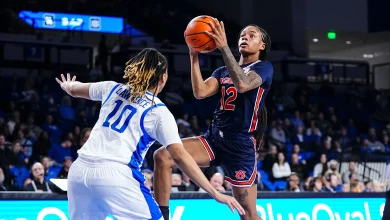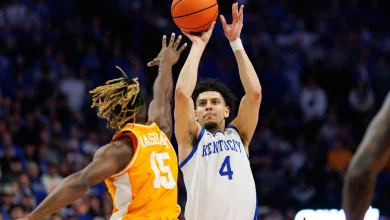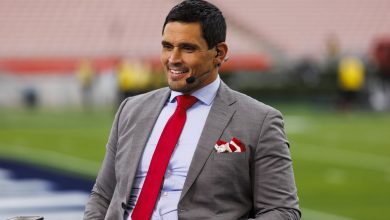Jordan Faison excels in both football and lacrosse at Notre Dame, but his dual-sport commitment comes with challenges.

Jordan Faison has made a name for himself as one of Notre Dame’s most talented athletes, balancing the physical demands of both football and lacrosse at a level few others can. As a standout on the football field and a key contributor to the lacrosse team, Faison represents the pinnacle of athleticism and versatility at the collegiate level. Yet, while his dual-sport career has earned him accolades and admiration, it has also come with significant challenges—challenges that require immense discipline, sacrifice, and mental fortitude.
Faison’s commitment to excelling in both sports at Notre Dame is a testament to his determination and love for athletics. However, his success has not come without its fair share of sacrifices. From the grueling schedules to the constant physical toll on his body, balancing football and lacrosse has often meant pushing his limits both physically and mentally.
A Rare Athlete
At the collegiate level, athletes who excel in multiple sports are incredibly rare. Most student-athletes focus their attention on a single sport, dedicating their time and energy to becoming the best they can be in that particular discipline. However, Faison is part of a small, exclusive group of athletes who are capable of succeeding in two different sports at the highest level.
Football at Notre Dame is a big deal, with the team consistently competing for national championships and boasting a long, storied history. Lacrosse, though less publicized, is also a significant part of the Notre Dame athletic program, and the Irish lacrosse team has been a powerhouse in the NCAA. Playing two such high-profile sports requires not only physical skill but also mental toughness. Faison’s ability to compete at a high level in both sports is a rare feat that demands an extraordinary amount of commitment and sacrifice.
The Demands of Playing Football and Lacrosse
Balancing football and lacrosse is no easy task, especially at a university like Notre Dame, where expectations for student-athletes are incredibly high. Each sport requires its own intense training regimen, and athletes must be at their peak performance to compete at the collegiate level. This means Faison has had to juggle two entirely different sets of physical and mental demands.
Football is a physically taxing sport that requires strength, speed, and endurance. The rigorous practice schedule, the physicality of the game, and the constant need for strategic preparation all add up to make football a demanding sport both mentally and physically. Football players, especially those in positions of leadership like Faison, often spend hours in the weight room, on the field, or in the film room preparing for their next opponent. This leaves little room for rest and recovery, as players must always be at the top of their game.
On the other hand, lacrosse, while not as physically demanding in terms of sheer size and strength, requires a different skill set and approach. Lacrosse athletes must possess agility, coordination, and quick reflexes, as well as an understanding of the flow of the game. Faison’s ability to shift between the two sports, each with its unique set of skills, is a testament to his versatility as an athlete. But this constant shift between two worlds means that Faison’s body is always in motion, always under pressure, and always striving to perform at a level that matches his competitors.
The Mental and Physical Toll
While Faison’s athletic prowess is undeniable, the mental and physical toll of playing two sports is substantial. College athletics, in general, can be exhausting—between practice, games, and travel, the schedule can be overwhelming. But when you add the challenge of two sports into the equation, the burden becomes even heavier.
The physical toll of playing two sports is one of the most significant challenges Faison faces. The constant strain on his body from football practices and games, coupled with the demands of lacrosse training and competition, leaves little time for recovery. Injuries, both minor and major, are common for athletes in one sport, but Faison has to manage the risks of injury in two. The risk of overuse injuries is higher when an athlete is training for and competing in two demanding sports, and Faison’s body has had to endure the wear and tear that comes with this commitment.
Beyond the physical, there’s a mental strain that comes with balancing two sports. The mental focus required to excel in both football and lacrosse is immense. Faison must always be prepared, both mentally and physically, for the next competition. The challenge of switching between the two sports, often during overlapping seasons, requires a level of mental discipline that few others can match. The need to stay sharp in both sports, while also managing the pressure of academics at a rigorous institution like Notre Dame, is a constant balancing act that requires exceptional time management skills.
Sacrifices and Personal Costs
While Faison’s success in both football and lacrosse is a remarkable achievement, it comes at a personal cost. For one, there is little time for rest. College athletes are already under immense pressure to perform academically, socially, and athletically, and adding the demands of two sports only intensifies the situation. Faison has had to sacrifice much of his personal time to dedicate himself to his dual-sport career.
Social life, downtime, and personal hobbies often take a backseat for athletes like Faison. With such a packed schedule, there’s little opportunity to relax or spend time with friends and family outside of the athletic world. Even the time that should be devoted to recovery and rest is often spent on another practice field or in a training room. These sacrifices, while necessary for success, can take a toll on an athlete’s well-being.
Furthermore, the pressure to excel in both sports is always present. While some may view Faison’s dual-sport status as a privilege, the expectations placed on him by coaches, teammates, and fans can be overwhelming. He must constantly prove himself, not just in one sport, but in two. This added pressure can be mentally taxing and lead to burnout if not managed properly.
The Reward: Legacy and Impact
Despite the sacrifices, Faison’s decision to pursue excellence in both football and lacrosse has created a lasting impact on both teams and the Notre Dame athletic program as a whole. His versatility and work ethic serve as an inspiration to younger athletes who may dream of excelling in multiple sports. Faison’s journey proves that with dedication, discipline, and passion, it is possible to succeed in more than one area of athletics, even at the highest level of college sports.
For the Notre Dame football and lacrosse programs, Faison’s contributions have been invaluable. His ability to thrive in both arenas has helped elevate both teams, and his leadership and determination have set a standard for future athletes. Faison’s dual-sport career at Notre Dame is a reminder of the rewards that come with pushing boundaries and stepping outside of one’s comfort zone.
Jordan Faison’s commitment to both football and lacrosse at Notre Dame is a rare and commendable achievement. The challenges that come with balancing these two sports are immense, yet Faison has continued to excel. His story is one of perseverance, resilience, and sacrifice, showing that it is possible to reach the pinnacle of athletic success while managing the demands of two elite sports.
While the road to achieving such excellence is fraught with physical and mental challenges, Faison’s journey is a testament to the power of hard work, dedication, and the unyielding drive to push oneself beyond limits. His legacy at Notre Dame will undoubtedly inspire future athletes to follow in his footsteps, and his dual-sport excellence will be remembered as one of the defining feats of college athletics.









